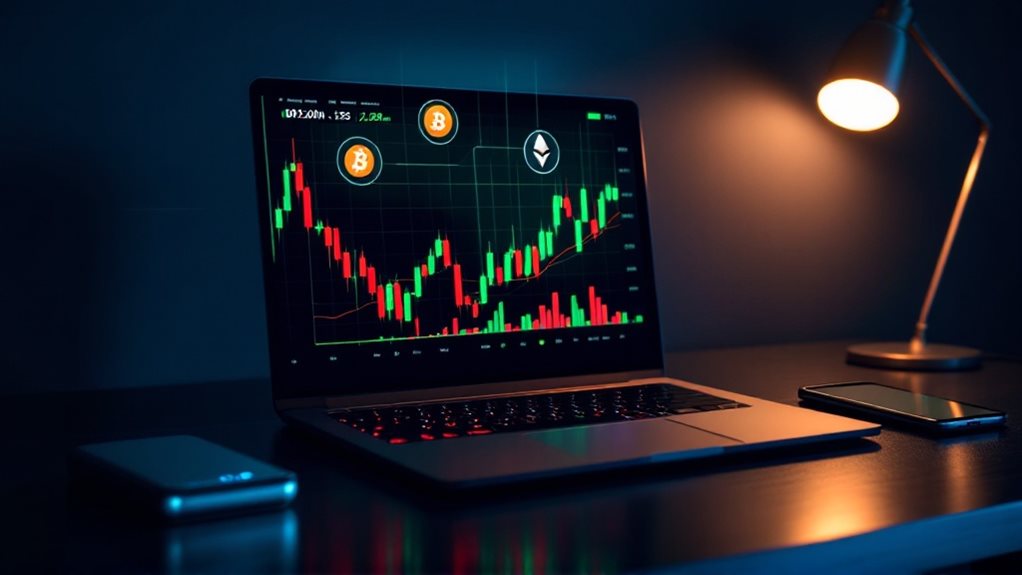Trading cryptocurrency starts with selecting a reliable exchange like Coinbase and setting up a secure account. New traders often begin with established cryptocurrencies like Bitcoin while studying market trends and price movements. Successful trading requires clear strategies, careful risk management, and consistent security practices like two-factor authentication. Traders track their activities, use hardware wallets for storage, and stay informed about market news. The journey into crypto trading unfolds with each step of understanding these fundamentals.
Quick Overview
- Select a reputable cryptocurrency exchange like Coinbase and complete identity verification before funding your trading account.
- Research popular cryptocurrencies like Bitcoin and Ethereum, focusing on market size, trading volume, and price history.
- Create specific trading strategies with clear entry and exit points, using technical analysis tools for informed decisions.
- Implement strict risk management by investing only affordable amounts and using position sizing to limit potential losses.
- Secure your investments with two-factor authentication and hardware wallets while staying updated on market news and trends.

Trading cryptocurrency has become increasingly popular in recent years. For those looking to enter the crypto market, the first step is selecting a cryptocurrency exchange. These platforms let users buy and sell digital assets. When choosing an exchange, traders compare factors like fees, security features, and which cryptocurrencies are available. Popular exchanges like Coinbase offer over 240 different cryptocurrencies for trading.
After picking an exchange, users create accounts and complete identity verification processes. They can then fund their accounts with regular money or transfer existing cryptocurrency. Understanding potential risks is crucial before making any investment decisions.
Before making any trades, successful crypto traders spend time researching which cryptocurrencies to buy and sell. They look at important metrics like market size and how often the crypto gets traded. Many traders start with well-known cryptocurrencies like Bitcoin or Ethereum. They study price history and how much the values change over time. Understanding the team behind each cryptocurrency project and their development plans helps traders make informed decisions. Controlling emotional behavior is essential since market volatility can trigger impulsive trading decisions.
Experienced traders develop clear strategies for their cryptocurrency trading. They decide specific prices for buying and selling different cryptocurrencies. Many use technical analysis tools that show price patterns and market trends. These tools include moving averages and something called the Relative Strength Index (RSI). Some beginners start with demo accounts to practice trading without risk. Traders often set automatic sell orders to help protect against big losses. Some prefer to invest small amounts regularly over time instead of all at once.
Risk management plays a big role in cryptocurrency trading. Traders track their activities carefully and keep detailed records for tax purposes. They typically avoid investing more money than they can handle losing, since cryptocurrency prices can change quickly. Many use position sizing, which means they only risk a small portion of their total account on each trade. Successful traders regularly review how well their strategies are working and make changes when needed.
Security remains a top priority in crypto trading. Most exchanges offer two-factor authentication, which adds an extra layer of protection to accounts. For people planning to hold cryptocurrency for a long time, hardware wallets provide a secure storage option. These physical devices keep digital assets offline and safe from online threats.
Traders also stay informed about market news and overall sentiment, as these factors can affect cryptocurrency prices. While the crypto market operates 24/7, traders often set specific times to check their investments and make trading decisions.
Frequently Asked Questions
What Happens to My Crypto if the Exchange Platform Goes Bankrupt?
If a crypto exchange goes bankrupt, customers’ assets might be frozen and considered part of the bankruptcy estate.
They’ll likely be treated as unsecured creditors and can’t withdraw their funds during proceedings.
There’s no FDIC insurance for crypto, unlike traditional banks.
The bankruptcy court decides who owns what and how assets get distributed.
This process can take months or years, and customers might only get back part of their holdings.
Can I Transfer Crypto Between Different Cryptocurrency Exchanges?
Yes, crypto can be transferred between different exchanges.
The process is similar to sending money between banks. Users need to get a deposit address from the receiving exchange, then enter that address in the sending exchange’s withdrawal section.
Many cryptocurrencies like Bitcoin, Ethereum, and stablecoins can move between exchanges.
The transfer time and fees vary depending on the cryptocurrency and network conditions.
How Are Cryptocurrency Trading Gains Taxed in My Country?
Cryptocurrency is treated as property for tax purposes in the US.
When someone sells or trades crypto, they’ll pay either short-term or long-term capital gains tax.
Short-term gains (for crypto held less than a year) are taxed at regular income rates from 10% to 37%.
Long-term gains (for crypto held over a year) are taxed at lower rates: 0%, 15%, or 20%, depending on income level.
State taxes may also apply.
What Security Measures Should I Take to Protect My Crypto Wallet?
Crypto wallet security relies on several basic protection measures.
Users can store private keys in hardware wallets – physical devices that keep crypto offline.
Two-factor authentication adds an extra layer of security beyond passwords.
Many people choose to encrypt their wallets and use strong, unique passwords.
Cold storage keeps large amounts of crypto offline, while regular software updates help patch security gaps.
Biometric locks add another security level.
Why Do Cryptocurrency Prices Vary Across Different Exchanges?
Cryptocurrency prices differ across exchanges due to several factors.
Each exchange’s liquidity level plays a big role – larger platforms like Binance tend to have more stable prices, while smaller ones see more price swings.
Local supply and demand also create price gaps between regions.
Trading fees and order book differences between platforms contribute to price variations.
Additionally, different countries’ regulations and cultural attitudes toward crypto affect local market prices.





